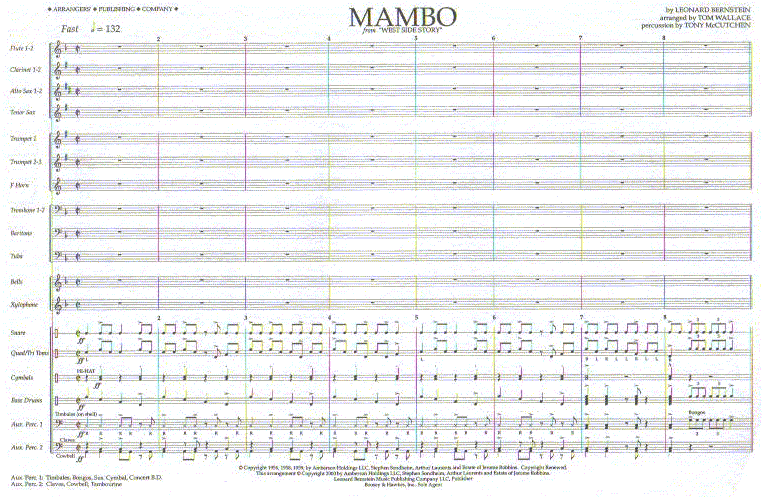On
August 25, 1918, Leonard Bernstein was born to two Russian-Jewish immigrants in
America. In his childhood he was exposed to a wide variety of music
because of his dad's musical experience and eventually began teaching
a piano class. He began his musical career by conducting pieces
and composing some as well. In the year 1957, Leonard Bernstein composed Mambo,
West Side Story. “West Side Story tells the tale of a love
affair between Tony, who is Polish American, and Maria, a Puerto Rican, set
against an urban background of interracial warfare.” The piece was
inspired by "Shakespeare's Romeo
and Juliet. The story is about two young people who fall in love but
are prevented from being together because their families are feuding." [1]
One
of the cultures included in Leonard Bernstein’s song was Afro-Cuban. Afro-Cuban
is described as a blend of Cuban, Latin American, and African musical
elements. He creates this rhythm in the beginning of the piece by opening
it with bongos and cowbells. The reason these instruments create the Afro-Cuban
rhythm is because the bongos where initially introduced in Africa, but further
developed in Cuba. Due to this the bongos are associated with Afro-Cuban
culture and music. The cowbells create a polyphonic sound which further creates
an Afro-Cuban sound which typically is polyphonic. The Genre of the piece is
Musical Theater because it was composed and later used in a play call West Side
Story. The Rhythm of this piece is Afro-Cuban rhythms. The meter of the
song is fast paced and syncopated. The piece is syncopated because the weak
beats are given more stress than the stronger beats. The texture of the
piece Mambo, West side story is dense and polyphonic.
Bernstein creates this texture by use very contrasting instruments such as
brass instruments and percussion instruments. There are also times throughout
the song where Bernstein uses different volumes to create the texture.
For example as one voice is in crescendo the other voice is in decrescendo.
This helps to establish a dense texture. The medium of the piece is Orchestra
with Latin Rhythm section which includes bongo drums and cowbells as mentioned
above. The song also includes trumpet riffs and complex counterpoints. The
brass instruments play accented chords, which add to the texture of the song,
and the wood wind instruments alternate rhythmic patterns with the brass
instruments. A solo brass instrument adds to the texture as it plays the melody
while the song because more polyphonic. Within the piece there are many voices
which include: brass instruments, woodwind instruments, string instruments, and
percussion instruments. The song is very sprightly and festive. Due to this it
is understood that the target audience is probably a young crowd or individuals
looking for a time to relax and have fun. The song ends by fading or crescendo
leaving the audience in suspense due to the beginning of the loud and
syncopated song. This makes the ending more dramatic because throughout the
piece there where rarely any pauses or piano sounding dynamics. Mambo
also has various occurrences of fortissimo which is when the song is played
loudly. The interesting thing about how the fortissimo is played is that the
composer, Bernstein, creates a fortissimo by alternating melodies among
instruments and with crescendos.
[1] "Bernstein’s West Side Story Opens." History.com. A&E Television
Networks, n.d. Web. 17 Apr. 2015.
<http://www.history.com/this-day-in-history/bernsteins-west-side-story-opens>.


No comments:
Post a Comment